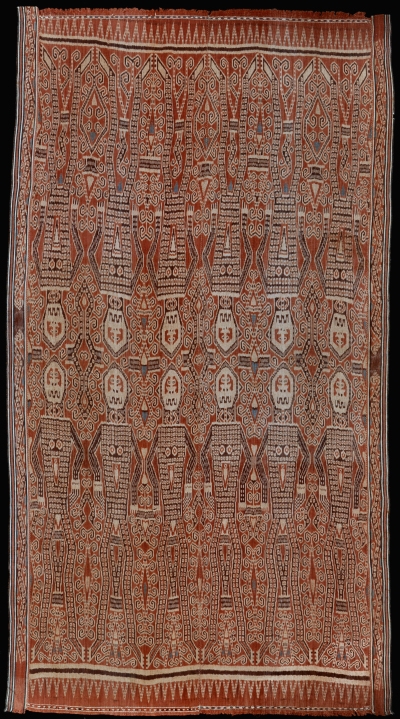| |
 
 | | | |
038 Borneo, Sarawak
Pua kumbu  
| | Locale: | Iban Dayak, Ngemah-Bangkit Rivers, Baleh, 7th (old 3rd) Division. | | Period: | 1880-1920 | | Yarn: | Cotton, hand-spun, medium | | Technique: | Warp ikat | | Panels: | 4 | | Size: | 145 x 267 cm (4' 9" x 8' 9") LW: 1.84 | | Weight: | 1410 g (49.7 oz), 364 g/m2 (1.19 oz/ft2) | | Design: | Twelve large human figures, engkeramba, with skull-like heads, covered in scales, interspersed with zoomorphic designs, snaking borders. Design intimately interwoven with ethos of headhunting. Figures are antu, giant ghostly creatures of power seen in dreams, representing protection and influence associated with deities or ancestors. The scale-like features of the warrior’s torso is the weaver’s interpretation of the actual war-jacket worn by him in battle which was re-enforced with hardy fish scales. Note that the bottom row figures have one crocodilian and one human hand, probably signaling that the weaver was struggling with the power of the crocodile. Nabau, snake, motifs in the border. | | Comment: | Very large 4-panel ceremonial blanket, 'spirit pua', of striking design and powerful associations. Executed in brick red, cream and brown with uncommon touches of faded indigo. Two very small holes in the field. Borders done as separate narrow panels. This blanket's patterns could only have been woven by a weaver of both great technical skills and mental prowess, as the design pattern entails some risk to weave given the nature of its subject matter. The fine black stripes along the selvedges are the hallmark of a very accomplished weaver who was given permission to use this mark in a dream. [Small image does not do justice to the visual impact of this exceptional cloth.] | | Background: | Chapters on Borneo and Sarawak. | | Exhibited: | Museu do Oriente, Lisbon, 2014/15.
Hong Kong University Museum and Art Gallery, 2017. | | Published: | Woven Languages, 2014.
Ikat Textiles of the Indonesian Archipelago, 2018.
| | Compare: | 151 | | Sources: | Similar pua, slightly less elaborate, in Khan Majlis, Indonesische Textilien, Wege zu Goettern und Ahnen, Fig. 688. Information on design and meaning provided by John Kreifeldt, based on information on very similar piece in his collection provided by Steven Alpert who field-collected it in the 1970s. Information relies heavily on further input from Steven Alpert and Vernon Kedit. | | |

©Peter ten Hoopen, 2025
All rights reserved.
|
|


